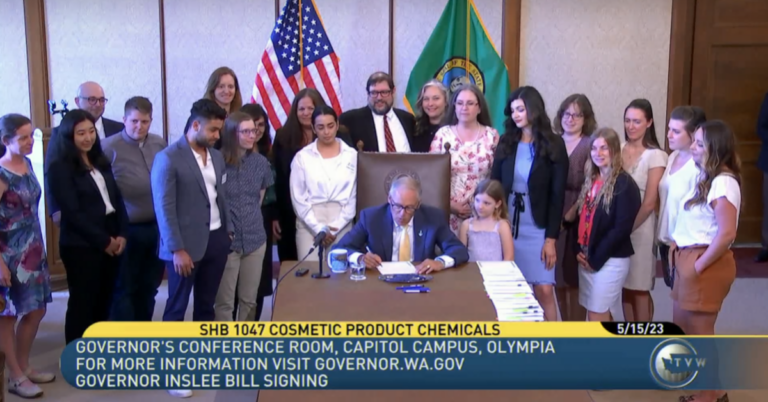Implementation of the Toxic-Free Cosmetics Act
What is the Toxic-Free Cosmetics Act?
Washington’s Toxic-Free Cosmetics Act (HB 1047), adopted into law in 2023, bans some of the most concerning chemicals put into cosmetic and personal care products, including PFAS, phthalates, formaldehyde, and formaldehyde releasing agents. It also set the first lead standard in the nation at 1 ppm. The bill plays an important part in making cosmetics and personal care products safer by helping to drive the transformation of global supply chains. What’s more, it begins to address environmental justice concerns, as harmful chemicals in cosmetics and personal care products disproportionately impact people of color. Similar laws were adopted in Oregon and Vermont following Washington.
What's happening now
- February 2025: The Department of Ecology released a draft rule that would ban all formaldehyde releasers in cosmetics and personal care products.
- August 13, 2024: In response to rulemaking, Toxic-Free Future and partners submitted a sign-on letter to the Department of Ecology urging the department to restrict all formaldehyde releasers that may be used in cosmetics.
- July 2024: The Washington Department of Ecology issued a preliminary draft rule to restrict formaldehyde-releasing chemicals in cosmetics and personal care products.
The Problem
Thousands of cosmetics and personal care products are used by people every day and the chemicals used to make them are largely unregulated.
The fact is that chemicals linked to cancer and developmental and reproductive harm are put into cosmetic products and personal care products. Besides potentially harming the person using the product, products with these toxic ingredients can also cause larger-scale pollution problems during manufacturing and after disposal.
Hazardous chemicals used in cosmetics and personal care products include:
- PFAS: Often used to make products waterproof (such as waterproof mascara). A recent study found PFAS in mascara, foundations, and lip treatments. A notorious drinking water contaminant, PFAS exposures are linked to a weaker immune response, cancer, increased cholesterol levels, pregnancy-induced hypertension, liver damage, reduced fertility, and increased risk of thyroid disease.
- Phthalates: These plasticizers derived from petroleum are often found in products with “fragrance” or “parfum” and are linked to reproductive harm.
- Formaldehyde and formaldehyde-releasing agents: Found in nail products, hair products, and even soap, formaldehyde is commonly released from preservative chemicals. It is a known carcinogen and skin irritant and has been identified as a cause of leukemia and nose and throat cancer, and linked to asthma and skin irritation.
Cosmetics in Us and Our Water
Cosmetics don’t just stay on our skin. Our bodies’ skin not only absorbs some of the harmful chemicals that are applied to it, but we can also inhale the chemicals or wind up ingesting them from products like lipstick.
- A 2021 peer-reviewed study found PFAS in 100% of breast milk samples tested. The study also found detections of PFAS currently being used in products like cosmetics and textiles doubling every four years.
- Studies have also found toxic chemicals used in cosmetics contaminating pregnant women, wildlife, and water bodies.
The chemicals also get flushed down the drain, into sewage treatment plants and/or septic systems. Some break down, but some don’t. They either wind up getting released into the waterways or concentrate in sewage sludge, which can be applied to forest and agricultural lands.
Communities of Color Unjustly Impacted
Communities of color are at a greater risk to be disproportionately exposed to toxic chemicals in the workplace, their communities, and from cosmetics. Products like hair relaxers (containing formaldehyde) and acrylic nails (containing phthalates, methacrylate compounds, and formaldehyde) are often marketed to or applied to customers by women of color.
According to a peer-reviewed study, African-American consumers purchase nine times more ethnic hair and beauty products than other groups and disproportionately purchase hair relaxers and straighteners. Asian Americans spend 70% more than the national average on skin care products. Workplace exposures can also disproportionately affect certain communities, with Vietnamese nail salon workers having higher exposure to phthalates.
Health concerns include:
- Researchers at the National Institute of Environmental Health Sciences (NIEHS) found that regular use of hair dye by black women resulted in a 60% increased risk of breast cancer.
- A 2022 study found an increased risk of uterine cancer in women who used hair straightening products.
State Governments and Companies Taking Action
A number of states have started taking action on toxics in cosmetics and personal care products. In 2022, California and Colorado adopted bans on all PFAS in cosmetics. California and Maryland adopted a ban on 24 hazardous chemicals in 2020-21. There has also been international action in other countries and regions, including in Europe, Canada or Japan.
Several companies are already meeting this challenge.
- Sephora set an ambitious goal to reduce dozens of toxic chemicals in brand-name formulated products, including phthalates, parabens, and formaldehyde releasers, and so far has achieved a 39.5% reduction in brand-name products with one or more toxic chemicals.
- Ulta requires the suppliers of its private-label products to eliminate chemicals of high concern (CHCs), which include parabens, formaldehyde-releasing preservatives, the antioxidants BHA & BHT, alkylphenol ethoxylates, and toluene and xylene in nail products.
- Whole Foods Market has prohibited more than 100 ingredients, including parabens, phthalates, formaldehyde donors, oxybenzone, and EDTA in all body-care products that it sells.
- Credo Beauty has prohibited more than 2,700 ingredients from their products based on safety and sustainability. These include formaldehyde, formaldehyde-releasers, PFAS, parabens, phthalates, triclosan, and many others. They also require additional transparency on ingredients and research on consumer safety and ingredient claims.
The Solution: The 2023 Toxic-Free Cosmetics Act
The Toxic-Free Cosmetics Act (HB 1047) is a first step in the solution to transforming the cosmetic and personal care products industry to make truly safer products.
This law:
- Bans hazardous chemicals, including PFAS, phthalates, formaldehyde, and lead in cosmetics by 2025;
- Fills important gaps in information on the hazards of chemicals used in cosmetics; and,
- Provides incentives for small businesses to make safer cosmetics.
It is clear that more needs to be done to address harmful chemicals in cosmetics and to get the industry to use safer solutions. In addition to strong implementation of the law, Washington state should lead the way and:
- Set goals for eliminating all high-hazard chemicals in cosmetics and personal care products by 2040;
- Require companies to assess hazards of all ingredients and make this information public; and,
- Only use the lowest hazard chemicals for the products we use on our bodies and flush down the drain.
A recent study shows that this is entirely possible. As part of ChemFORWARD’s Know Better Do Better program, a report on the sector shows how companies are using hazard assessments to identify chemicals to phase out, prioritize data gaps for investment, and quantify their use of safer chemistry.
Comments submitted by Toxic-Free Future
Latest news on the Toxic-Free Cosmetics Act




